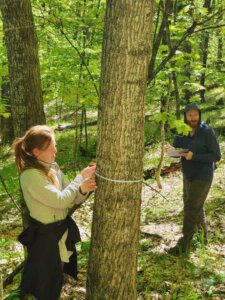Biodiversity is important for all natural landscapes. Plant and animal wildlife impact each other in various ways, with deer having a particularly powerful effect on plant life. Within Palmer Woods Forest Reserve the Leelanau Conservancy is exploring just how much deer influence the forests they inhabit.
Deer play an essential role in woodland ecosystems. Their grazing shapes plant communities, their droppings aid in nutrient cycling, and they’re necessary prey for other wildlife. As they travel through the forest, they aerate the soil, promoting healthy plant growth. However, their growing numbers pose a challenge, risking overgrazing and hindering forest regeneration.
In 2016, the Leelanau Conservancy created two deer exclosures in Palmer Woods Forest Reserve to get an idea of how much deer impact the forest. This past spring, stewardship staff ventured into the exclosures for the second time to check in on the project. Land Steward Emily Douglas talks about early findings of what a woodland without deer looks like.
LC: Talk to us about deer browse. What is it, and what are its impacts?
Emily: “Deer love to eat almost everything in the woods and gardens, they love it all. They think it’s all for them. They will eat everything at their height, so basically anything under six feet. They do prefer some plants over others. They don’t love beech trees, but native orchids are like candy for them. So, they’re eliminating certain species, not allowing trees to reach heights they need to become mature adults. The impact of deer browse is deep and filters far into the ecosystem.”
LC: How were the plots for the deer exclosure chosen?
Emily: “When we knew we wanted to put in the deer exclosures, and do this big deer study, we knew we needed a great ecologist to help us create the study and analyze the data. We hired a local expert ecologist who studied the topography of the land, canopy cover, ground cover, and all these different components. For every plot chosen for inclusion in the deer exclosure, an ecologically similar plot was chosen for comparison outside the exclosure.”
LC: You and the Stew Crew have recently started exploring the exclosures. What have you been seeing?
Emily: “We’re only seeing the iceberg tip. We talk about being on ‘forest time,’ so it will be a long study, 100 plus years. Within the next 10 to 30 years, we’ll really start to see those impacts and see how they can change the forest. But in these first seven years, you notice little things like, for example, finding many more species that get browsed. Things like elderberry are showing up, which you don’t see a ton in the forest world because it gets munched very quickly. Outside of the exclosure, the ash trees are all being browsed down. Inside the exclosure, they’re able to grow tall. And we know the outlook for ash isn’t great, but they can’t become resistant to Emerald Ash Borer if they can’t grow to maturity to begin with.”
LC: How will the exclosures continue to change over time?
Emily: “The forest is complex; even without deer in the picture, a forest has its own impact on itself. Allowing a forest to grow tall and have more canopy, which is what a forest needs, allows those other species to thrive. Canopy allows the understory, the shaded layer between the canopy and forest floor, to flourish. An understory supports different plants and animals adapted to lower light conditions. Both layers are necessary for health and biodiversity in a forest ecosystem.”
LC: What are we going to do with the information found?
Emily: “We hope it will be a resource for others who work in forestry. The intention is that, in doing this long term study, we’ll have this great data set and can share it. It’s also about understanding what balance looks like. We protect land for deer, too. When places are developed, it puts more pressure on non-developed places for deer. So, they congregate more in natural areas, but the impact of browsing isn’t great. It’s an interesting problem to have. We’re curious to see more of how the exclosure changes over time.”





